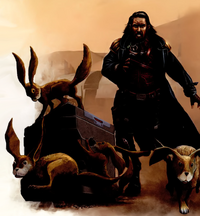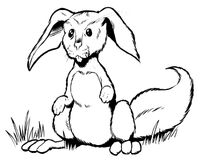Squalls were small lagomorphs native to the planet of Chandrila.
Overview[]

A group of squalls on Chandrila
These fur-covered creatures were known for having long ears, and a distinctive hopping gait. On average, they weighed 5 kilograms and reached lengths of 30 to 40 centimeters. Squall instinctively seemed to want to be around other non-predatory creatures of any species, including sentient species. When in the company of other creatures, they typically begged for food or raided unguarded food stores. In the Core Worlds, squalls were renowned for their cuteness, and even further out, most beings found it hard to see them as anything but adorable. On Chandrila, squalls were normally allowed to roam in and out of the cities as they desired. Thus, they were the cause of much traffic trouble and annoyance to offworlders; to reduce this slightly, squall maintenance was introduced to the government's work budget, which went toward pushing the squall population back out of urban centers just after mating season every year.
Despite the fact Chandrila normally applied strict laws to the smuggling of animals off world, squalls so commonly wandered aboard ships left unlocked that it generally was not even noted by the local authorities and the very worst a spacer would receive was a small fine. However, it was against the law to kill or capture squalls without a permit, due to the huge off-world trade of squalls as pets or food.
Squalls were incredibly popular and common pets in the Core Worlds, especially since most young girls either had one or wanted one. The market off of Chandrila was not hugely profitable, but was steady due to the species seeming to not breed well away from their home. Despite this, numerous breeds were also found on Rori. As pets, squalls were popular not only with young girls, but also as gifts to loved ones during some romantic festivals. To be pets, squalls had to be domesticated and raised from birth, as despite the fact they could be picked up on the street on Chandrila, wild squall were unlikely to stay with a single being and would sometimes even bite to escape if picked up. Domesticated squalls, on the other hand, didn't seem to try to escape from owners and, if left alone for more than 12 hours, would begin to whine. With such popularity among children, abandonment was a common problem for squall, as on planets other than their homeworld, squall couldn't tell the difference between predators and friendly creatures due to the fact they would have learned such things while growing up in the wild. This commonly led to stray domesticated squall living very short lives.

A squall
Squall meat was also very popular, especially in the Expansion Region, where upper-class diners enjoyed food imported from the Core Worlds. Given that it was also easily transportable and relatively inexpensive, it was a common dish in both high-end restaurants—where a pair of squall would often be served in a rich sauce under the name Chandrilian tendermeat—and low-end diners, where it would simply be sold as "squall meat" or squallburgers. Eateries were encouraged to only purchase squall meat with the official Chandrilian positive ecology seal of approval, which showed that the squall the meat came from had been raised in humane conditions. Squall meat not bearing this seal often came from battery-farmed animals, a problem the Chandrilan government tried to solve by acting more harshly toward the smuggling of large herds of squall. Squall meat was usually stringy, but had a very powerful flavor hard to mask, which made it a perfect food to be poisoned, as even some food taster's couldn't taste toxins in squall meat.
A large variety was the leviasquall.
Behind the scenes[]
The squall that Allana Solo followed in the Millennium Falcon novel wore a vest and directed her into a small opening. This is an obvious allusion to the White Rabbit in Alice in Wonderland.
Appearances[]
- Star Wars Galaxies: An Empire Divided
- Star Wars Galaxies: The Ruins of Dantooine
- Tatooine Ghost (as an art)
- Invasion 2
- The New Jedi Order: Edge of Victory II: Rebirth (First appearance)
- Millennium Falcon
- Millennium Falcon audiobook
Sources[]
- The Essential Guide to Planets and Moons
- Coruscant and the Core Worlds
 "Domesticated Squall" (original article link) on Wizards.com (content now obsolete; backup link)
"Domesticated Squall" (original article link) on Wizards.com (content now obsolete; backup link)- Star Wars Galaxies: An Empire Divided Quick Reference Guide
- Star Wars Galaxies: The Total Experience: Prima Official Game Guide
- Star Wars Galaxies: The Complete Guide: Prima Official Game Guide
 Holopets on the official Star Wars Galaxies website (content now obsolete; backup link)
Holopets on the official Star Wars Galaxies website (content now obsolete; backup link) Friday Feature – Pet'tastic Friends! on the official Star Wars Galaxies website (content now obsolete; backup link)
Friday Feature – Pet'tastic Friends! on the official Star Wars Galaxies website (content now obsolete; backup link)- Star Wars: Age of Rebellion Beginner Game
- Star Wars: Age of Rebellion Core Rulebook
- Strongholds of Resistance
Notes and references[]
- ↑ 1.0 1.1 1.2
 "Domesticated Squall" (original article link) on Wizards.com (content now obsolete; backup link)
"Domesticated Squall" (original article link) on Wizards.com (content now obsolete; backup link)
